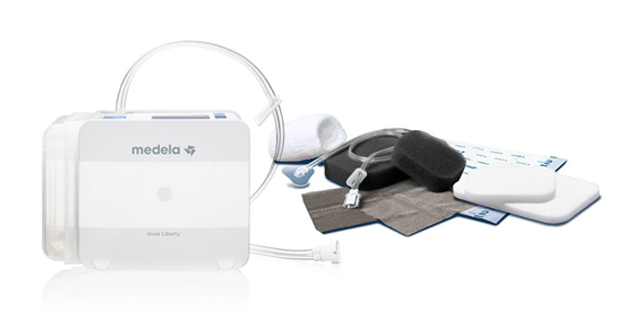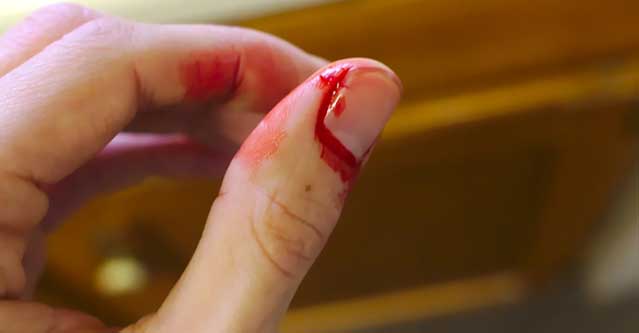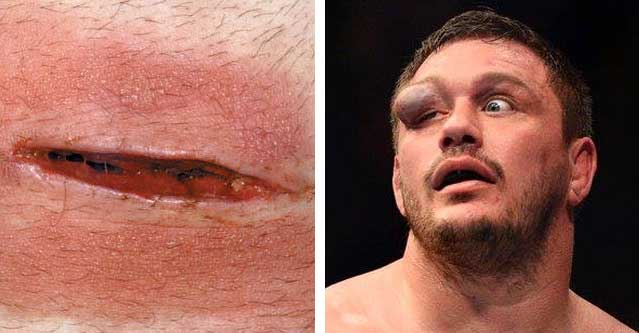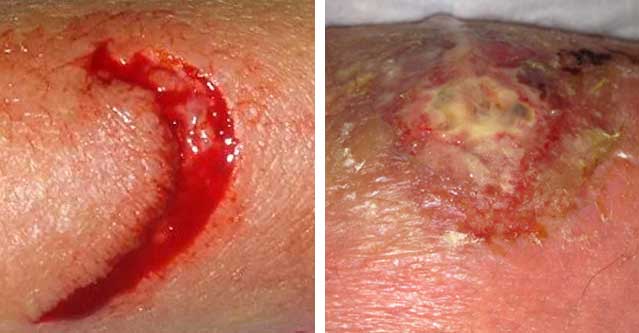Different Types Of Wounds.
Know Your Wounds, It's Half The Battle.

Wound VACs Heal These Types of Wounds.
Wound VACs are a great way to heal your wounds in a fast, and efficient way.
But, unfortunately this awesome medical device does not work on all wound types, therefore it's very important to know what kind of wound you're dealing with.
Wounds VACs Work Great On:
- Chronic Wounds
- Acute Wounds
- Traumatic Wounds (Cuts, Lacerations, or Punctures That Cause Damage To Skin, and Underlying Tissue)
- Subacute Wounds
- Dehisced Wounds
- Partial-Thickness Burns
- Ulcers (Such As Diabetic, Pressure, or Venous)
- Flaps
- Grafts
Below we explain the different types of wounds, therefore you know exactly what wounds you're dealing with.
So, Without Further Ado...

Acute, and Chronic Wounds.
As each of us move through daily life, it's very likely that you will sustain different types of wounds. The most common of wounds are on the outside of the skin. These wounds are usually simple, and heal as expected, therefore they are classified as Acute Wounds.
Examples Are:
- Abrasions (Scrape of the outer skin)
- Minor Lacerations (Tear like wounds)
Acute Wounds that do not heal in the usual time for that wound type are classified as Chronic Wounds.
When your wound turns from acute, to chronic it takes a longer time to heal, and might even result in complications. It's very important for chronic wounds to be taken seriously, because when left untreated they can result in death.
Examples of Chronic Wounds Are:
- Infections Wounds
- These are wounds that get infected from either bacterial, fungal, or viral causes.
- Ischemic Wounds
- When your wound does not get a sufficient amount of blood supply for it to heal correctly you have an ischemic wound.
- Radiation Poisoning Wounds
- This wound type is caused by the over exposure to radiation. Whether the radiation exposure is therapeutic, or accidental, radiation may weaken your immune system, cause damage to exposed tissue, and ultimately delay wound healing time.
- Surgical Wounds
- If any wound that is caused by a surgical procedure does not get the proper blood supply, or wound care it will take longer to heal.
- Dehisced Wounds
- These wounds are a common complication with Surgical Wounds. This wound type happens when any surgical wound breaks open along your sutures, resulting in wound dehiscence.
The Most Common Chronic Wounds Are Ulcers:
- Arterial Ulcers
- Occur from hypertension, atherosclerosis (plugging), and thrombosis (clotting), in which the reduced blood supply causes an ischemic state.
- Venous Ulcers
- This ulcer type is associated with deep vein thrombosis, varicose veins, and venous hypertension. These ulcers can lead to stasis, where your blood fails to circulate in the normal fashion.
- Diabetic Ulcers
- A common complication in uncontrolled diabetes mellitus, which results in lessened immune function, ischemia, and neuropathy, eventually resulting in your skin breaking open, and ulceration.
- Pressure Ulcers
- Constant pressure, and friction resulting from body weight, or other pressure over a prolonged period of time can lead to your skin breaking, and ulceration. (aka Bed Sores)

Open, Closed, and Miscellaneous Wounds.
Another way to classify different types of wounds are whether they are open, closed or miscellaneous . Each wound type can be very serious, and are classified depending on how the wound takes place.
When you're dealing with any type of open wound it will be classified based on the object that caused the wound.
Examples Of Open Wounds Are:
- Incisions, or Incised Wounds
- Caused by a clean, sharp edged object creating the wound, such as a knife, razor, or even a glass shard.
- Lacerations
- Irregular tear-like wounds that are caused by some type of blunt trauma. This wound type can appear to be linear (regular), or stellate (irregular). Because how this wound looks it can often be mis-classifed as an incision.
- Abrasions
- Wounds in which the top layer of the skin is scraped off. This wound type is usually caused by sliding your skin across a rough surface.
- Avulsions
- This wound type is when you sustain an injury in which a body part is forcibly detached from its normal location. You can think of this like an amputation where the extremity is pulled off, rather than cut.
- Puncture Wounds
- These wounds are caused by an object puncturing the skin, like when you step on a nail, get a splinter, or get poked with a needle.
- Penetration Wounds
- A penetration wound is caused by an object, like a knife entering, and coming out from the skin.
- Gunshot Wounds
- These wounds are caused by a bullet, or similar projectile driving into the body. Often these wounds will cause two wounds, an entrance, and exit wound. (aka Through-and-Through)
Now that we have an understanding of they different types of open wounds, let's move onto closed wounds.
Closed wounds are much easier to classify, as there are just a few categories. It' important to know closed wounds can be just as dangerous as open wounds, therefore you should take them seriously.
Examples Of Closed Wounds Are:
- Hematomas
- This wound is caused when there is damage to a blood vessel that causes blood to collect under the skin.
- When your hematomas wound originates from internal blood vessel pathology they are classified as petechiae, purpura, and ecchymosis. These classifications depend on the size of the wound.
- If your hematomas wound originates from an external source of trauma they are considered contusions, or often referred to as a bruise.
- This wound is caused when there is damage to a blood vessel that causes blood to collect under the skin.
- Crush Injury
- This type of injury is sustained by a great force applied on an area, over a long period of time.
The last type of wound that you can get are miscellaneous wounds. These wound types are any wound that can't be classified by either open, or closed.
Examples Of Miscellaneous Wounds Are:
- Thermal Wounds
- These wounds are caused by extreme temperatures, no matter if they are caused by hot, or cold. Some types of thermal wounds are frostbite, burns, and sunburn.
- Partial Thickness Burn
- This wound type is more serious than a first degree burn because a deeper layer of your skin is burned. This burn type can send you into shock if more than 10% of your body is burnt because you can lose to much fluid from the burn area.
- Chemical Wounds
- This wound type is caused by contact, or inhalation of chemicals that cause skin, or lung damage.
- Bites, and Stings
- Wounds that are caused by getting bit, or stung are classified as bites, and stings. These can be dog, cat, snake bites, or even insect stings.
- Electrical Wounds
- When you come in contact with extreme high voltages, you may experience electrical wounds. These wounds can be very serious, and may include servere internal damage.

Clean, Contaminated, Infected, and Colonized Wounds.
You can also classify your wound based on the level of contamination that it has.
It's very important that you keep your wounds clean, because you will have a much lower chance of infections, and further complications.
- Clean Wounds
- This is a wound that was made under sterile conditions, in which no organisms are present, and the skin is likely to heal as expected.
- Contaminated Wounds
- Wounds that usually happen from accidental injury in which pathogenic organisms and foreign bodies are in the wound.
- Infected Wounds
- When you have a wound that has pathogenic organisms present, and multiplying your wound is infected. Usually indicated by signs of infection. (Yellow Appearance, Soreness, Redness, Oozing Pus)
- Colonized Wound
- Wounds occurring from a chronic situation, that contain pathogenic organisms. These wounds are usually difficult to heal.
